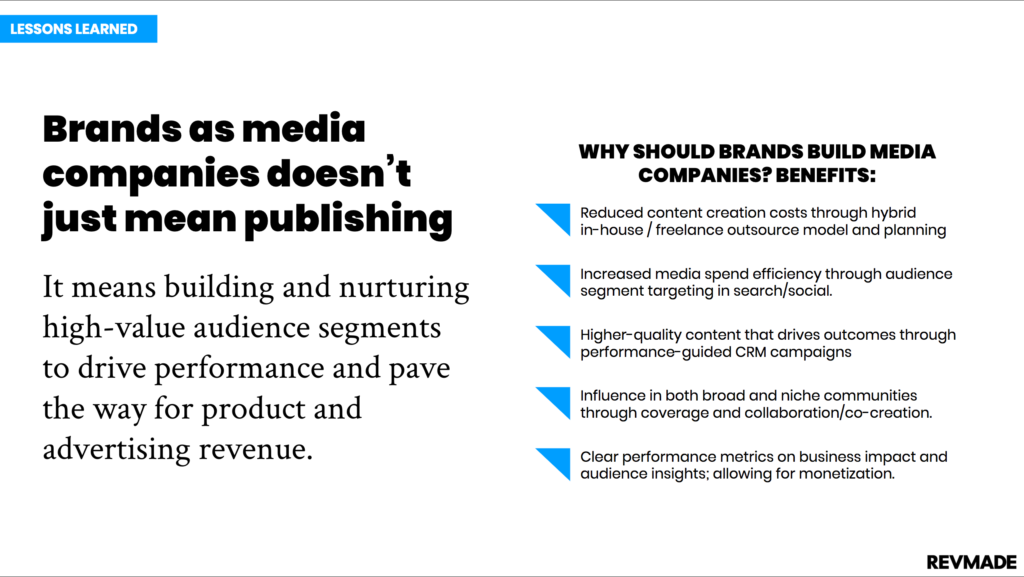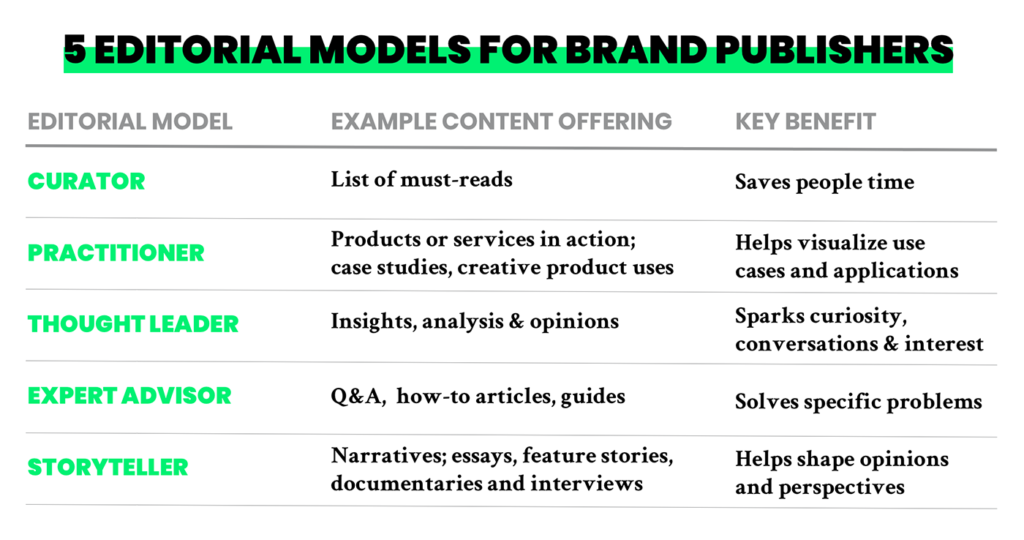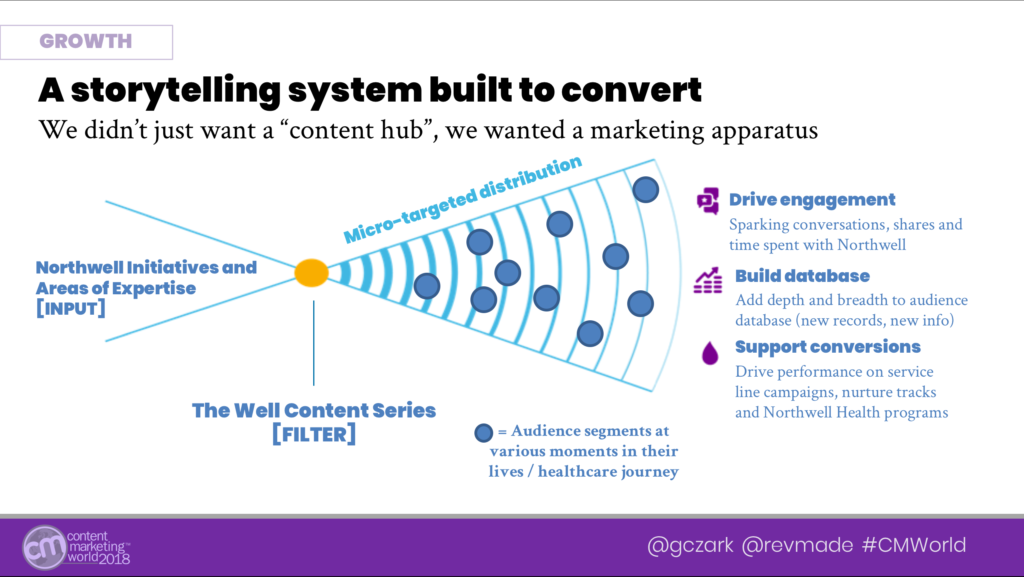Focus on building editorial franchises, not ‘content marketing’
Are you empowered to solve problems for your audience as your primary goal? It’s an important question as content marketing strategy matures. Our company has spent the last three years creating and improving editorial products for brands, associations and media companies. In that time, we’ve noticed a marked difference in results from projects that have focused on great editorial service — those that really understood the audience and what they needed — from those that simply aimed to quickly attract and transact without taking into consideration what the audience actually requires to absorb and convert.
Projects borne from a commitment to audience service tend to develop stronger audience relationships and bring more value back to the organizations that fund them. Simply put, editorial programs are assets that can develop into subbrands that drive actual business value.
Editorial product development is an important sub-discipline developing within content marketing, and we’ve developed a 6-step playbook for brands looking to get it right.
Step #1: Build the Business Case

Why would a company invest in an editorial entity?
Many of us in marketing intuitively know that owning an audience is better than renting one; we would jump at the opportunity to have the ongoing audience connection, data and conversion potential. But most executives don’t because they have a million other things they are worried about, they’ve heard content is pretty cheap, and/or they believe you’re already doing it.
Building the business case for an editorial product involves showing them the path: How attention has changed; how audiences reward high-value content; what it takes to form the basis of a loyal relationship. Then, importantly, the vision for your new product, and how you plan to meet your goals through the investment.
Step #2: Create the Editorial Product Strategy
Clayton Christenson’s “Jobs to Be Done” framework brilliantly lays out how to think about product development: Every person is “hiring” a product to perform a job. Editorial “products” should be developed with this in mind — what “job” is this editorial performing for our audience?
How you attract audiences and gain their loyalty depends on creating a differentiated editorial product that meets an underserved need in your market. As more companies produce more content, a strong editorial strategy will be a key differentiator that delivers more value in the future than it does today.
Your approach to editorial product strategy needs to take into consideration:
- The audience that you most want to attract
- The job that audience needs to complete; what they will hopefully “hire” your content to do (i.e. does it save them time through curation and tools? Does it demystify tough decisions through expert analysis? Does it inspire them to change their status quo?)
- The personality of your brand, and how that translates into content tone
- How your brand will leverage this audience / the value it holds for the organization, and a hypothesis on how to unlock it
- The resources you have available
Step #3: Develop Content Series

What actual types of content will be produced to deliver on the strategy? What formats will the content be offered in? If your task is to save your audience time, for example, you may look to repeatable formats like bulleted enewsletters that recap the most important news and information of the past 24 hours.
The keys here are creativity and specificity: Look to other media companies in other markets for inspiration and think about the products you love to read, listen to, or watch. And, be as specific as possible when planning what you will deliver: If your concept is at all vague (“Articles” or “News briefs”), you likely will have a hard time with execution and differentiation.
Step #4: Create an Audience Map and Distribution Checklist

Somehow, two things are true when it comes to how we promote content: We’re both not promoting it enough, AND we’re overwhelmed by how many channels we are already promoting it in. These problems arise from two areas:
- An undifferentiated content strategy that doesn’t really solve the problems of our target audience and/or
- A focus on the wrong channels to begin with
For example, many marketers care more about Twitter than email, even though email offers better response rates, better attention quality and better value back to the business. This stage is about organization and execution: Determining which channels to be in and execution of that channel strategy on each piece of content that’s produced.
Step #5: Build the Plan to Make Money
This step isn’t necessary for every brand that wants to launch an editorial brand — in fact many just want to drive 100% of the equity from their investment back to their own products.
But it is an option, and for some ( in particular those with partnerships built into their existing business model) the idea of renting space to partners via advertising (or a co-op or partner model) is attractive because it subsidizes marketing spend.
There are companies we’ve helped that actually drive profit from their marketing in this way. Much of the groundwork and research for this step should be tackled in step #1, and now it’s about execution of ad tech and a sales strategy.
Step #6: Measure / Analyze / Improve
We launched a new editorial brand a few weeks ago, and I spent a long time engrossed in the analytics to see what behaviors we could already suss out. First surprise: Our “print this article” template was terrible, and we were getting questions about how to print the content.
It turns out the audience group wanted to share paper copies of the content at their meetings and events, which were frequent in the industry. So, we are fast-tracking a print template.
The key here is to continue to stay on top of each step we’ve outlined through step #6, just like an editorial media company would do, to get the most value out of the investment. With another editorial brand, we saw that a particular content series was referring visits and driving conversions at a higher rate than other series — so, of course, we prioritized developing and integrating more of that particular series content into additional campaigns and were able to accelerate the gains.
As content marketing continues to grow in popularity, an editorial product strategy is a key way to differentiate your brand. While it requires more legwork and time for buy-in, strategy and planning, the results — and growth potential — are worth it. R
Subscribe
Get our weekly newsletter for tips on how to drive better content marketing performance.
For a regular stream of ideas, research and links we find helpful. And of course, to say hi!
